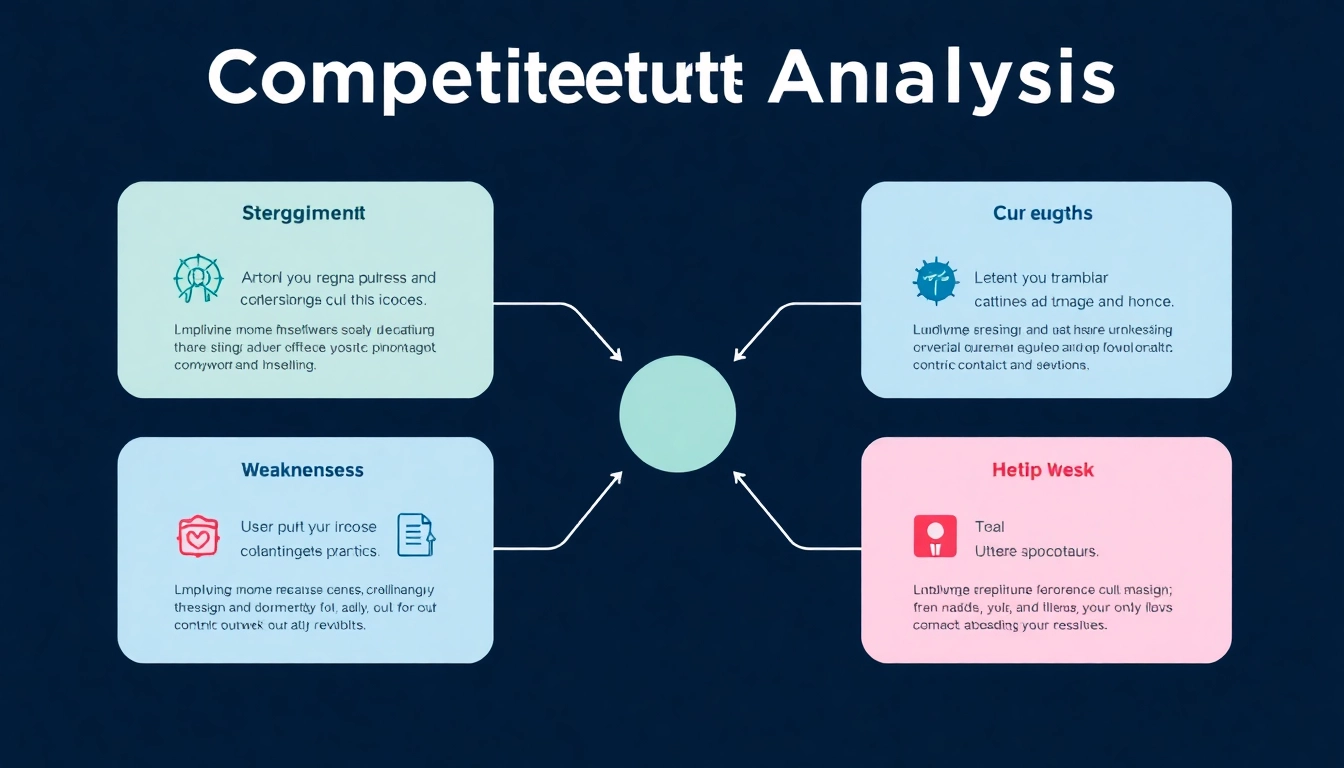
Understanding Competitor Analysis
Definition and Importance
Competitor analysis, also referred to as competitive analysis, is the process of examining similar brands in your industry to gain insights into their offerings, branding, sales, and marketing approaches. This appraisal is crucial for businesses that aim to refine their strategies and carve out a competitive edge. Notably, it allows companies to understand not only what their competitors offer but also how they position themselves in the market and engage with customers. Through competitor analysis, businesses can identify areas of opportunity, adjust their value propositions, and refine their marketing tactics.
Understanding competitor analysis goes beyond simple observation; it involves an in-depth study of various aspects such as market share, pricing strategies, promotional tactics, and product quality. The insights garnered can be transformative, leading to increased market relevance and improved customer satisfaction.
Types of Competitor Analysis
There are several types of competitor analyses that businesses typically employ:
- Direct Competitor Analysis: This focuses specifically on those businesses offering the same products or services within the same geographic region.
- Indirect Competitor Analysis: Here, the analysis includes competitors who may not offer identical products but fulfill the same customer needs.
- Market Position Analysis: This involves determining how various competitors are positioned within the market, looking at factors like brand perception and customer loyalty.
- Product Analysis: This method focuses on dissecting the product offerings of competitors to understand their features, benefits, and unique selling propositions.
- Pricing Analysis: Analyzing how competitors price their products and services can provide insights into pricing strategies and customer expectations.
By categorizing the analysis into these types, businesses can take a structured approach to understanding their competitive environment, which ultimately informs their strategic decisions.
The Competitive Landscape Overview
The competitive landscape is an ever-evolving ecosystem characterized by various players, including direct and indirect competitors, emerging startups, and alternative solutions. Mapping this landscape requires a multi-faceted approach:
- Identify Key Players: Utilize market research to identify those within your direct and indirect sphere. Who are the top players, and who poses a threat to your market share?
- Evaluate Their Strategies: Assess the marketing, branding, and operational strategies of competitors to identify gaps and opportunities.
- Understand Customer Needs: Research how competitors address customer pain points and their overall approach to customer satisfaction.
- Track Trends: Keep an eye on industry trends including technological advancements, regulatory changes, and shifts in consumer behavior, which may influence the competitive landscape.
Having a comprehensive understanding of the competitive landscape is vital for making informed business decisions and guiding future strategies.
Key Components of a Competitive Analysis
Identifying Your Competitors
The first step in a thorough competitive analysis is identifying who your competitors are. This includes both direct competitors—those who sell the same products or services—and indirect competitors that might satisfy the same needs through alternative means. Conduct market research to identify various competitors and classify them based on their offerings and market reach. Techniques for identification include:
- Conducting thorough market research through tools like SWOT analysis.
- Utilizing online databases, industry reports, and various analytical tools to pinpoint competitors.
- Engaging with customers to learn who they consider as alternatives.
Accurately identifying competitors is crucial for any successful competitive analysis because understanding who you are up against lays the groundwork for deeper analysis.
Analyzing Strengths and Weaknesses
After identifying your competitors, the next step is conducting a strength and weakness analysis. This process involves assessing both qualitative and quantitative aspects of competitors’ businesses:
- Strengths: Identify what your competitors do well. This could include pricing strategies, customer service, product features, or their market reputation.
- Weaknesses: Pinpoint areas where competitors lack. Perhaps they have poor customer support, limited social media presence, or negative reviews that impact their reputation.
Being aware of these factors is essential for developing strategies that can capitalize on competitors’ weaknesses or build upon your strengths.
Market Position and Branding Strategies
Understanding how competitors position themselves in the market is fundamental for differentiating your brand. This encompasses not only what they offer but also how they communicate their value to the customer. When analyzing market position and branding strategies, consider the following:
- Brand Messaging: Analyze the tone, style, and content of your competitors’ messaging. Is it professional, casual, humorous? What impact does it have on customer perception?
- Customer Engagement: Review how competitors interact with their customers through social media, blogs, newsletters, and community engagement.
- Market Penetration: Determine how effectively they have captured their target audience and whether you have an opportunity to do better.
Evaluating these dimensions will help you find angles for your marketing approach that stand out amidst the noise.
Tools and Techniques for Conducting Analysis
Top Competitor Analysis Tools
The digital age provides access to numerous tools that can streamline and enhance the competitive analysis process. Here are some top contenders:
- SEMrush: Ideal for conducting SEO analysis, assessing competitors’ keywords, and understanding their online visibility.
- SimilarWeb: Provides insights into website traffic sources, audience demographics, and engagement metrics.
- Ahrefs: Perfect for backlink analysis and understanding competitors’ content strategies.
- BuzzSumo: Helps identify the most shared content and influencers in your competitor’s niche.
- SpyFu: Focuses on analyzing competitors’ PPC performance and uncovering their keyword strategies.
These tools can save time and enhance the accuracy of your analysis, enabling more informed decision-making.
Using Data Analytics in Your Research
Data-driven decision-making is at the heart of effective competitor analysis. By leveraging analytics, businesses can quantify their insights, making for a stronger case in strategic planning. Data analytics can be utilized by:
- Gathering Metrics: Collect data on competitors’ web traffic, social media engagement, and conversion rates to benchmark performance.
- Identifying Trends: Use historical data to identify trends in consumer behavior, sales cycles, and marketing effectiveness.
- Predicting Outcomes: Develop predictive models to forecast potential growth areas or risks based on current market dynamics.
Embracing data analytics not only augments your insights but also lays the groundwork for developing effective strategies.
Leveraging Social Media for Insights
Social media can serve as a goldmine for competitor insights. Engaging in social listening—monitoring both competitors and industry trends—will help you to identify:
- What content resonates most with your and competitors’ audiences.
- Trends and shifts in customer sentiment or feedback.
- Potential gaps in competitors’ offerings that you could exploit.
Leveraging social media effectively can provide real-time feedback and data-driven insights, allowing your business to adapt quickly to changing market dynamics.
Implementing Findings Into Your Strategy
Adjusting Marketing Strategies
The insights gathered from competitor analysis should not sit idle. Instead, they should inform and shape your company’s strategies moving forward. Consider the following steps for implementation:
- Refine Value Proposition: Use analysis insights to enhance your value proposition, ensuring it clearly articulates your unique benefits.
- Adjust Pricing: Re-evaluate your pricing structure relative to competitors to ensure market competitiveness.
- Tailor Marketing Campaigns: Focus on marketing initiatives that capitalize on identified gaps in competitor strategies.
By actively adjusting your marketing strategies based on competitive insights, your business will stand a stronger chance of attracting and retaining customers.
Measuring Success Post-Analysis
After implementing your competitive analysis findings, it’s crucial to measure your success. Performance metrics to consider include:
- Market Share Growth: Track shifts in your market share over time.
- Customer Acquisition Costs: Monitor how changes in strategy impact the cost of acquiring new customers.
- Customer Engagement Rates: Examine engagement on social media and other platforms to understand how customers are responding to your new strategies.
- Sales Growth: Evaluate increases in sales to determine effectiveness.
Consistently measuring these metrics aids in understanding whether your adjustments are yielding positive results.
Continuous Monitoring and Adaptation
The competitive landscape is dynamic, and for strategies to remain relevant, continuous monitoring is essential. Implementing a system for regular analysis allows businesses to:
- Stay Ahead of Trends: By continually monitoring industry trends and competitors, you can be proactive rather than reactive.
- Refine Strategies: Periodically reassess and fine-tune your approach based on changing dynamics and emerging competitors.
- Encourage Innovation: Ongoing competitive analysis fosters a culture of innovation and adaptability within your organization.
In summary, instituting a cycle of continuous improvement driven by competitor analysis can enhance long-term business viability.
Case Studies in Competitive Analysis
Successful Campaigns
Numerous businesses have effectively leveraged competitive analysis to achieve success. For instance, a leading retail chain analyzed the online presence of its top competitors and shifted its marketing strategy to focus heavily on digital channels as a result. This pivot not only increased its market share but also drastically improved customer engagement through targeted campaigns. Key takeaways from successful cases point to the importance of adaptability and a willingness to experiment and iterate based on competitive insights.
Lessons Learned from Failed Strategies
Not all strategies derived from competitive analysis lead to success. For example, a tech startup that attempted to undercut prices without understanding market value perception ultimately found itself unable to sustain its business. This underlines the fact that while competitive analysis provides critical insights, executing strategies without a deeper understanding of market positioning, customer needs, and brand essence can have detrimental effects.
Industry-Specific Best Practices
Different industries have varying approaches to competitive analysis. For example, in the fast-moving consumer goods sector, companies tend to analyze not only direct competitors but also substitutes and changing consumer preferences regularly. Alternatively, in the B2B space, competitor analysis might focus greatly on relationship-building, sales strategies, and longer-term contractual obligations. Understanding these nuances will further enhance a company’s ability to craft effective competitive strategies tailored to their specific contexts.






